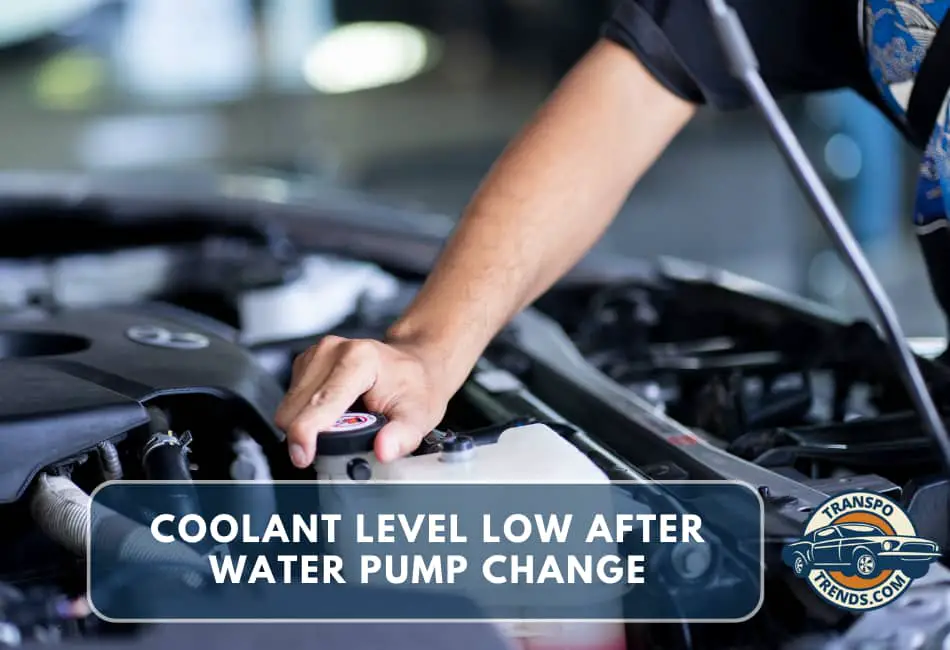Your vehicle’s cooling system, often overlooked, is the silent guardian of your engine, consistently managing heat to ensure optimal performance.
Central to this system is the water pump, a key player in distributing the coolant to ward off potential overheating issues.
Yet, following a water pump replacement, you might face a perplexing problem: a sudden drop in coolant level.
This piece will explore the top six reasons contributing to this phenomenon after a water pump change.
You can steer clear of future engine difficulties by identifying and learning how to tackle these factors.
Sit still as we guide you through the nuances of coolant levels, air bubbles, and the mastery of maintaining a cool and robust engine.
1. Air Pockets
Air pockets, or airlocks, in your cooling system, are often unexpected consequences of a water pump replacement.
This occurs when air, trapped in the system during the pump replacement, displaces the coolant.
Instead of a consistent flow of coolant, these air pockets interrupt the cycle, potentially leading to an inaccurate reading of the coolant level.
The Impact of Air Pockets on Coolant Circulation and Levels
An air pocket can significantly hinder the circulation of coolant. The air pocket, less dense than the coolant, tends to rise to the highest point in the cooling system, often the thermostat.
This can cause the thermostat to stay closed, blocking the flow of coolant and leading to overheating.
Additionally, it can also create a false reading of the coolant level, making it seem as though the level has dropped suddenly after the water pump replacement.
Steps to Bleed Air from the Cooling System
Bleeding air from the cooling system is a critical step following a water pump replacement to ensure accurate coolant levels. Here are the steps to follow:
- Ensure the engine is cool before starting.
- Open the radiator cap to release any built-up pressure.
- Start the engine and set your heater to the highest setting.
- As the engine warms up, you’ll see the coolant level drop. This is the air being displaced.
- Top up with coolant as necessary, maintaining the manufacturer’s recommended level.
- Replace the radiator cap once the engine reaches operational temperature and the coolant level stabilizes.
2. Coolant Leak
After a water pump replacement, there’s a possibility of experiencing coolant leaks. The primary reason typically lies in the improper sealing of the water pump or the damage to the gasket during installation.
The coolant can escape through these compromised areas, reducing the coolant’s level and efficiency.
Over time, these leaks can lead to significant engine issues, including overheating and damage to engine components, necessitating immediate attention.
Identifying Signs of a Coolant Leak
Detecting a coolant leak early on can prevent serious damage to your vehicle’s engine. The most common signs include a low coolant level warning light, consistent need for coolant top-up, or visual spotting of the leak.
Additionally, if you notice a sweet, syrup-like smell coming from your car or see a bright green, pink, or yellow fluid pooling under your vehicle, it could be a sign of a coolant leak.
How to Inspect For and Fix Coolant Leaks
Inspecting for a coolant leak involves visually examining the water pump, radiator, and hoses for signs of leakage, such as wet or discolored areas.
You can also use a pressure tester to check for leaks. Identify the source and replace the faulty component if necessary to fix the leak.
For a leaking water pump, ensure the pump is properly sealed and the gasket is in good condition.
If the leak is substantial, it’s recommended to engage the services of a professional mechanic to carry out the repair.
Remember, it’s critical to refill your coolant to the appropriate level after fixing the leak to ensure optimal cooling system performance.
3. Insufficient Coolant Refill
Proper coolant replenishment plays a pivotal role in the performance and longevity of your car’s engine.
The coolant serves as a heat transfer medium, taking excess heat from the engine and dissipating it through the radiator.
Without adequate coolant, your engine can overheat, potentially causing severe damage and expensive repairs.
Step-by-Step Guide on How to Refill the Cooling System with Coolant
Refilling your vehicle’s coolant system is a straightforward process that you can carry out yourself. Follow these steps:
- Ensure Your Car’s Engine is Cool: Always allow your engine to cool before refilling the coolant. Opening the radiator cap while the engine is hot can lead to severe burns due to the pressure and heat.
- Locate the Coolant Reservoir: The coolant reservoir is usually a translucent plastic tank near the radiator. The reservoir should have markings indicating the minimum and maximum coolant levels.
- Open the Reservoir Cap: Remove the cap from the coolant reservoir.
- Pour in the Coolant: Slowly pour it into the reservoir until it reaches the maximum fill line. Don’t overfill it; the coolant needs space to expand as it heats up.
- Replace the Cap and Clean Up: Once you’ve filled the reservoir, replace it, ensuring it’s secured. Clean up any spills to avoid staining your driveway or garage floor.
How to Check the Coolant Level and Top It Off If Necessary
Regularly checking your coolant level can help you identify a potential leak early and ensure your engine stays cool. Here’s how to check and top off your coolant:
- Perform a Visual Check: Visually inspect the coolant level in the reservoir with the engine cool. You’ll need to add more if it’s below the minimum mark.
- Add Coolant: Follow the steps outlined in section B to add more coolant to your vehicle.
- Check the Level Again: After adding coolant, check the level again. If it’s still below the minimum, continue to add coolant until it’s within the appropriate range.
- Monitor the Coolant Level: It’s important to monitor the coolant level over the next few drives. If the level drops quickly, it may indicate a leak requiring professional attention.
4. Bleeding Process
It’s important to note that some vehicle models require a specific cooling system bleeding, also known as burping, after adding new coolant.
This process is necessary because it helps to remove any air that may have become trapped in the cooling system during the coolant replacement.
When air pockets are present, they can prevent the coolant from flowing freely through the system, resulting in insufficient cooling and potential engine damage.
Hence, the bleeding process is integral to maintaining the health and performance of your vehicle’s engine.
How to Properly Bleed the Cooling System
To properly bleed the cooling system, follow the steps below:
- Start the Vehicle: With the coolant reservoir cap off, start the vehicle. Leave it running for a few minutes. This allows the engine to warm up and the coolant to circulate, pushing any air bubbles to the top.
- Bleed the System: Find the bleed valve (usually located near the thermostat). Slowly open this valve using a wrench, allowing any trapped air to escape. You will hear a hissing sound, which is a good indication that the air is being expelled.
- Monitor the Coolant Level: As the air escapes, the coolant level in the reservoir will drop. Keep an eye on this and add more coolant as necessary to maintain it within the appropriate range.
- Close the Bleed Valve: Once all the air has been bled out and only coolant is released from the valve, close it securely with the wrench.
- Top Up the Coolant: If necessary, add more coolant to the reservoir to ensure it’s at the correct level. Replace the reservoir cap securely.
The Importance of Following Manufacturer Guidelines
Every vehicle has unique specifications and maintenance requirements, and the cooling system is no exception.
Always consult your vehicle’s owner manual for specific instructions on bleeding the cooling system.
Adhering to the manufacturer’s guidelines ensures your engine’s longevity and guarantees your safety.
Ignoring these guidelines could lead to improper maintenance, resulting in serious engine damage, costly repairs, or even accidents.
5. Overheating Issues
The water pump is a vital component of the engine’s cooling system. It circulates the coolant throughout the engine, absorbing heat and dissipating it to prevent overheating.
If the water pump fails, the coolant flow is hampered, leading to engine overheating. If you observe signs such as a coolant leak, noise from the water pump, or an overheating engine, it’s time to inspect and potentially replace your water pump.
How Overheating Can Lead to Coolant Loss and Low Levels
Overheating can compromise the integrity of the cooling system and lead to coolant loss. For instance, extreme heat may cause the coolant to boil over and escape from the reservoir, lowering the coolant levels.
Additionally, overheating can also cause damage to components like hoses and gaskets, leading to coolant leaks.
It’s essential to regularly check your coolant levels and look out for any visual evidence of leaks in your garage or parking spot.
Actions to Take if You Suspect Engine or Head Gasket Issues
If you suspect engine or head gasket issues, immediate action is critical. Signs like white smoke from the exhaust, milky oil, or coolant loss without visible leaks may point to a blown head gasket—a major engine issue.
If these symptoms are present, stop using the vehicle immediately to prevent further damage and consult a certified mechanic or your vehicle manufacturer.
Professional diagnosis and repair are essential, as fixing such issues without the necessary expertise could lead to more harm than good.
6. Residual Air
It’s not uncommon for air pockets to linger in the cooling system after maintenance or repair. These trapped air pockets can interrupt the flow of the coolant and cause overheating.
Bleeding the cooling system, a process of flushing out the air is usually the solution. This can be done using the bleed screws near the top of the engine or by running the engine with the radiator cap off until the air bubbles out.
Steps to Monitor and Address Gradual Coolant Level Decreases
Gradual decreases in the coolant level might indicate slow leaks or evaporative loss. Routinely checking the coolant reservoir is crucial.
If you notice consistently lowering the coolant level, it’s time to look closer. Inspect the integrity of the hoses, gaskets, and the radiator for any signs of leaks.
Also, checking the ground where your vehicle is parked for any colored fluid can help identify if there’s a leak.
When to Seek Professional Help if the Issue Persists
If the issues persist despite your best efforts, or if you’re not comfortable performing these inspections and actions yourself, it’s best to seek professional help.
Persistent overheating, unexplainable coolant loss, or the presence of white smoke or milky oil are all serious signs indicating a potential engine or head gasket issue.
In such scenarios, consult a certified mechanic without delay. They have the knowledge, expertise, and tools necessary to diagnose and fix the problem accurately, avoiding further damage to your vehicle.
Conclusion
A. There are several reasons why you might experience low coolant levels after a water pump replacement, including inaccurate coolant level checks, leakage from gaskets or hoses, trapped air in the system after maintenance, coolant evaporation, radiator cap issues, or more serious problems like an engine or head gasket issue.
Maintaining the proper coolant level is vital for the health of your vehicle’s engine. It enables the engine to operate within its designed temperature range, preventing overheating and undue wear on engine parts.
Regular vehicle maintenance can help identify and resolve many potential issues early on, ensuring the longevity and performance of your vehicle.
If you encounter persistent issues or symptoms that you cannot explain or fix, we strongly recommend seeking the assistance of a certified mechanic.
They possess the expertise and tools to accurately diagnose and address the issue, thereby preventing further damage to your vehicle.

